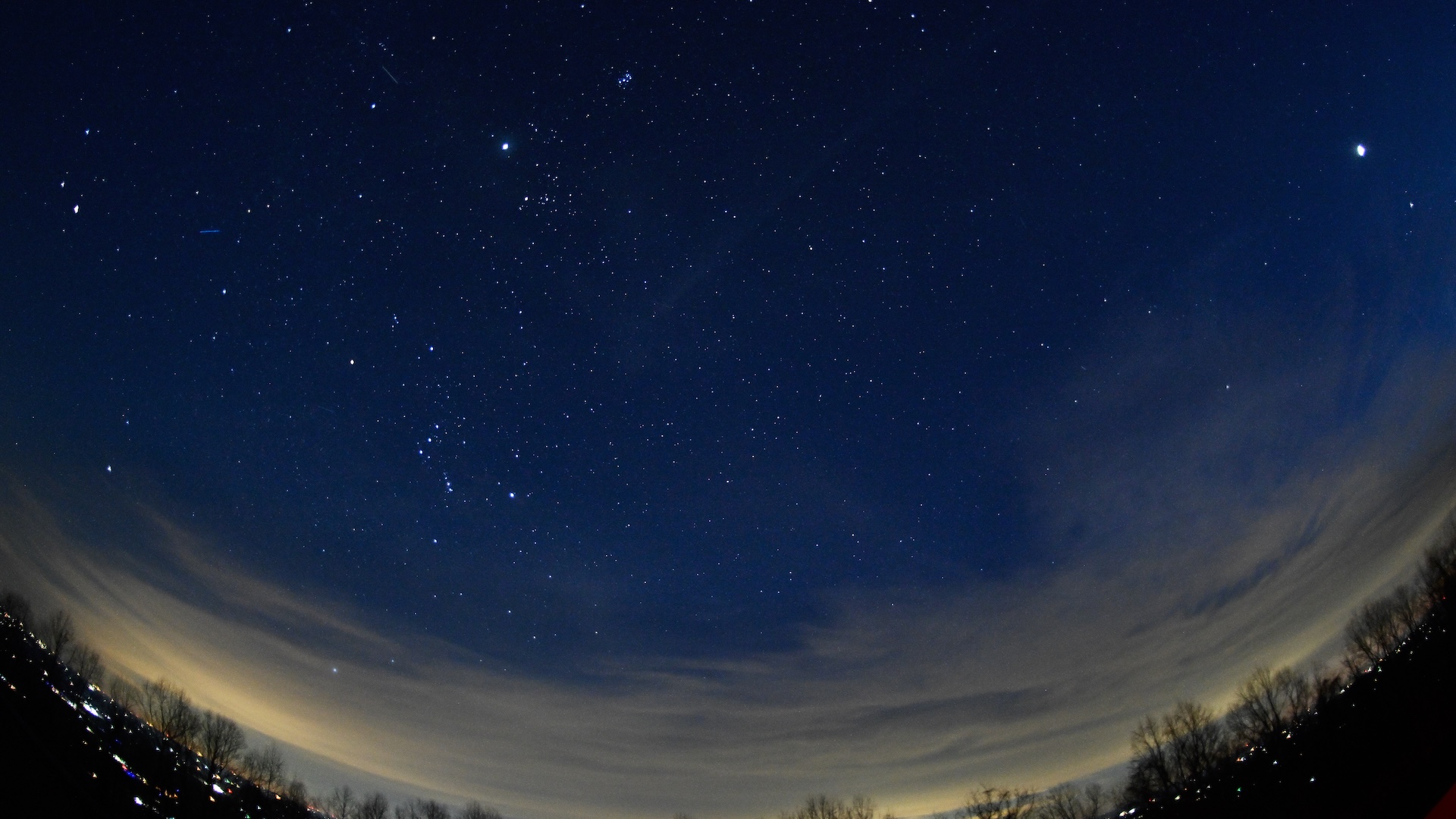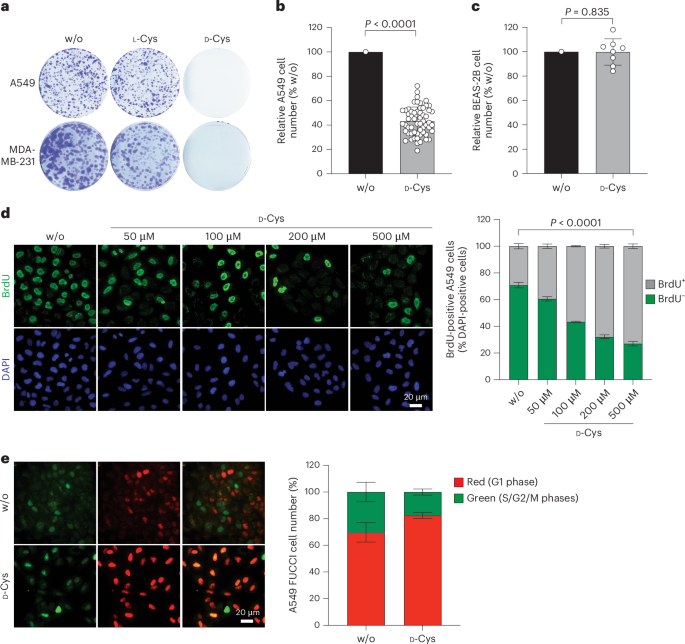Cell culture
Human lung adenocarcinoma A549 cells (American Type Culture Collection (ATCC) CCL-185, gift from the lab of P. Hofman, IRCAN, Nice, France), human breast adenocarcinoma MDA-MB-231 cells (gift from the lab of D. Picard, University of Geneva, Switzerland), human bronchial epithelial BEAS-2B cells (ATCC CRL-9609, gift from the lab of P. Hofman), human tumorigenic lung BZR cells obtained by transfer of the v-Ha-ras oncogene into BEAS-2B cells (ATCC CRL-9483, gift from the lab of P. Hofman), human lung epidermoid carcinoma Calu1 cells, human melanoma A375 cells (ATCC CRL-1619, gift from the lab of P. Hofman), human cervix cancer HeLa cells, human colon cancer HCT116 and DLD1 cells, lung adenocarcinoma LuCa62 cells derived from a patient (gift from V. Serre-Beinier, CMU, Geneva, Switzerland), human embryonic kidney HEK 293 cells and human retinal pigment epithelial RPE-1 cells were grown in DMEM high-glucose media supplemented with 10% FBS, 2 mM l-glutamine, 100 U ml−1 penicillin and 100 µg ml−1 streptomycin at 37 °C and 5% CO2. Mesothelioma JL1, ZL34 and H2052/484 cell lines (gift from V. Serre-Beinier) were grown in RPMI 1640 with GlutaMAX media (Life Technologies, 61870-010) supplemented with 10% FBS, 100 U ml−1 penicillin and 100 µg ml−1 streptomycin (Corning, 30-002-CI) in an incubator at 37 °C and 5% CO2. A549 Bax/Bak double knockout cells were a generous gift from A. Sfeir (Sloan Kettering Institute).
Cell culture treatments
For the IC50 determination of d-Cys or d-cystine, and for most proliferation analyses, cells were seeded in six-well plates at a density of 5 × 103 cells per cm2, unless specifically mentioned, and incubated overnight at 37 °C. Cells were then treated with d-Cys (Carl ROTH, 7874.1) or d-cystine (Sigma-Aldrich, 285463) at the indicated concentrations. When not specified, d-Cys was used at 500 µM. For cell counting assays, cells were harvested by trypsination at the indicated times and counted in 0.4% trypan blue solution using a Neubauer counting chamber. For metabolic and proteomic analyses, cells were lysed 72 h after the treatments. For biochemical analyses, A549 and BEAS-2B cells were seeded into tissue culture flasks at densities between 32 × 103 and 4 × 103 cells per cm2, grown overnight, supplemented with 500 µM d-Cys for the following 2 days, subjected to a medium exchange including d-Cys replenishment, and harvested the next day. For erastin treatment, 24 h after seeding the cells were treated with 1 µM compound (Sigma-Aldrich, E7781) in the presence or absence of 500 µM d-Cys. Seventy-two hours later, cells were harvested and counted as described above.
Transient Cys-free cultivation of A549 cells was performed in Cys-free/Met-free DMEM (Thermo Fisher, 21013-024), with addition of 200 µM methionine and standard supplements. When indicated, cells were grown in the presence of 375 µM TCEP. Tissue culture media including l-Cys, d-Cys or erastin supplements were freshly prepared and exchanged daily. The autoxidation of d-Cys and TCEP under normoxic tissue culture atmosphere was monitored in 50 mM Tris/HCl buffer (pH 7.4) by Ellman’s reagent DTNB (5,5′-dithiobis-(2-nitrobenzoic acid).
For hypoxia experiments, the culture medium was pre-equilibrated for 4 days in a sealed hypoxic chamber maintained at 1% O2 and 5% CO2 before initiating the experiment. A549 cells (1.5 × 105 cells per well) were seeded overnight in six-well plates, after which the medium was replaced with pre-equilibrated hypoxic growth medium. The cells were cultured with or without 500 μM d-Cys. The plates were then placed in a sealed, humidified hypoxic chamber containing 1% O2 and 5% CO2 and incubated at 37 °C for 72 h before performing cell counting or crystal violet staining.
Colony formation assays
A total of 1,000 cells per dish were seeded in 6-cm dishes and incubated overnight at 37 °C. Twenty-four hours later, cells were treated with 100 µM d-Cys for 2 weeks. Cells were then washed with PBS, fixed in 4% paraformaldehyde (PFA) solution and stained with 0.5% crystal violet solution (Sigma-Aldrich, C0775) in 30% ethanol for 20 min. The stained cells were then washed with H2O and left to dry overnight.
Spheroid formation assays
A total of 1,000 cells per well were seeded in culture media containing 100 µM to 500 µM d-Cys in 96-well plates coated with 1.5% agarose. Spheroid volume was quantified by light microscopy twice per week for 17 days.
Generation of CRISPR–Cas9 knockout cells
A549 cells were transduced with lentivirus containing lentiCas9-Blast plasmid (gift from F. Zhang, Addgene plasmid no. 52962). After 24 h, cells were selected with 5 µg ml−1 blasticidin for 7 days. After selection, cells were seeded at one cell per well in 96-well plates for cell cloning. Following single-cell colony formation, clones were screened for Flag expression and one Flag-positive clone was selected. Then, Cas9-expressing cells were infected with lentivirus containing a single guide RNA (sgRNA) of interest in lentiGuide-Puro vector (Addgene, plasmid no. 52963). For each gene of interest, two sgRNAs were used. The sgRNA target sequences used were as follows:
SLC3A2 (CD98)-1: GACCTTACTCCCAACTACCG;
SLC3A2 (CD98)-2: TGAGTGGCAAAATATCACCA;
SLC7A11 (xCT)-1: AAGGGCGTGCTCCAGAACAC;
SLC7A11 (xCT)-2: GAAGAGATTCAAGTATTACG;
NFE2L2-1: CACATCCAGTCAGAAACCAG;
NFE2L2-2: CATACCGTCTAAATCAACAG;
NCOA4-1: AGATTGGCTAGTGACTCCCC;
NCOA4-2: GAGGTGTAGTGATGCACGGA.
After 24 h, cells were selected with 5 µg ml−1 puromycin for 7 days and expression of the gene of interest was verified by western blotting.
Pooled gRNA depletion screen
Cas9-expressing A549 cells were infected with the human CRISPR Brunello lentiviral pooled library (Addgene, 73178-LV) at a multiplicity of infection of 0.3 such that every gRNA is represented in 500 cells. After 48 h, infected cells were selected with puromycin for at least 6 days. After selection, 40,000,000 cells were seeded per condition to maintain the expression of the whole library. The following day, cells were treated with H2O (control condition) or with 500 µM of l-Cys or d-Cys. Cells in control and d-Cys conditions were passaged every 3 days and maintained at a minimum of 40,000,000 cells. Cells in the d-Cys condition were refreshed with media containing 500 µM of d-Cys every 3 days until the emergence of resistant clones. At least 40,000,000 cells were collected for genomic DNA extraction at day 0 after selection and at the end of the treatment (day 11 for control and l-Cys conditions, and day 24 for d-Cys condition). Genomic DNA was extracted from cell pellets. gRNA inserts were amplified via PCR using primers harbouring Illumina TruSeq adapters with i5 and i7 barcodes, and the resulting libraries were sequenced by next-generation sequencing on an Illumina HiSeq 4000.
Overexpression of SLC3A2 and SLC7A11 in BEAS-2B cells
To generate the SLC3A2 plasmid the sequence AgeI-SLC3A2-XhoI-3xGly linker-FLAG-STOP-EcoRI was inserted between the AgeI and EcoRI sites of TRIPz replacing the TurboRFP. To make the SLC7A11 plasmid the sequence AgeI-SLC7A11-SalI was inserted between the AgeI and XhoI sites of the SLC3A2 construct giving AgeI-SLC7A11-SalI/XhoI-3xGly linker-FLAG-STOP-EcoRI. The final sequence of both plasmids was verified.
BEAS-2B cells were infected with lentivirus containing pTRIPz-EGP (gift from the lab of D. Picard), pTRIPz-SLC3A2-Flag or pTRIPz-SLC7A11-Flag. After 24 h, cells were selected with 5 µg ml−1 puromycin for 7 days. After selection, cells were seeded for d-Cys treatment at 100 µM in combination with 100 ng ml−1 doxycycline. After 72 h, cells were harvested and counted.
Transient overexpression of SLC3A2 and SLC7A11 in HeLa cells
Open reading frames of C-terminally FLAG-tagged SLC3A2 and SLCA11 were subcloned into pEGFP-derived mammalian expression vectors (TaKaRa) by substitution of the EGFP open reading frame using standard cloning techniques. Transfection of HeLa cells by electroporation22 was performed in 265 µl of buffer using 6 µg of each CD98-encoding and xCT-encoding plasmid or 12 µg of a reference vector encoding a PEST-sequence destabilized EGFP. After overnight tissue culture, cells were supplemented with 500 µM d-Cys. Two days later, medium including d-Cys was replaced and cells were harvested the following day. Cells were thus exposed to d-Cys for a total of 3 days.
Generation of A549 FUCCI cells
A549 cells were transduced with lentivirus containing pBOB-EF1-FastFUCCI-Puro plasmid (gift from the lab of D. Picard, Addgene plasmid no. 86849). After 24 h, cells were selected with 5 µg ml−1 puromycin for 7 days. Surviving cells were seeded on coverslips in six-well plates, for d-Cys treatment as described above, then fixed for 20 min at room temperature in 4% PFA solution. The coverslips were washed and mounted on slides for imaging. The proportion of cells in G1 phase (mKO-hCdt1, red probe) and in S/G2, G2 or M phases (mAG-hGeminin, green probe) was quantified.
Immunofluorescence procedures
BrdU staining
Cells were seeded in six-well plates containing coverslips and treated with increasing concentrations of d-Cys as described above. After 72 h, cells were incubated with 10 μM BrdU for 8 h in cell culture medium at 37 °C. Then, cells were washed, fixed for 20 min at room temperature in 4% PFA solution and permeabilized in PBS containing 0.15% Triton X-100 for 10 min at room temperature, before addition of 2 M HCl to denature DNA. Cells were then incubated in PBS containing 0.15% Triton X-100 and 5% normal goat serum for 30 min at room temperature and incubated in a solution containing anti-BrdU antibody (Sigma-Aldrich, 11170376001) diluted at 1:200 and 5% normal goat serum at 4 °C overnight. The last step of immunostaining was performed according to standard immunocytochemistry protocols.
DNA damage staining
Cells were seeded in six-well plates containing coverslips and treated with d-Cys as described above. After 72 h, cells were washed, fixed for 20 min at room temperature in 4% PFA solution and permeabilized in PBS containing 0.15% Triton X-100 for 10 min at room temperature. Cells were incubated in PBS containing 0.15% Triton X-100 and 1% BSA for 30 min at room temperature and incubated in anti-53BP1 and anti-γ-H2AX antibodies diluted at 1:50 and 1:200, respectively, in a solution containing 1% BSA, at 4 °C overnight. The last step of immunostaining was performed according to standard immunocytochemistry protocols.
Immunofluorescence detection of xCT and CD98
For immunofluorescence, cells were cultured on glass coverslips in 24-well plates for 2 days seeded at a low density of 12,500 cells per well and at a high density of 2 × 105 cells per well. Cells were washed two times with cold PBS, fixed in 1% PFA for 12 min, followed by rinsing with and incubating with methanol (MeOH) at −20 °C for 5 min, and 2× washes in PBS. Cells were permeabilized with 0.2% of Triton X-100 in PBS (5 min at room temperature) and saturated for 20 min with 2% of BSA in PBS. Incubation with primary antibodies (xCT; 1:200 dilution) was carried out for 2 h at room temperature, followed by washing 3× with PBS; incubation with anti-rabbit secondary antibody (Supplementary Table 7) and rhodamine-phalloidin (Thermo Fisher Scientific, R415; 1:400 dilution) was carried out for 1 h at room temperature, followed by 3× washes with PBS. Coverslips were mounted with Fluoromount-G. Slides were imaged on a Zeiss LSM 800 confocal microscope using a Plan-Apochromat ×63/1.40 oil objective (1,024 × 1,024 pixels). Maximum intensity projections of z-stack images (typically 3–6 confocal planes over 1.0–1.5 µm, step size = 0.3 µm) were obtained. z-sections were collected in 0.27-μm steps over 6 µm. Images were extracted from .czi files using ImageJ, adjusted and cropped using Adobe Photoshop, and assembled in Microsoft PowerPoint.
Electron microscopy
Cells grown on Permanox slides were washed in 100 mM phosphate buffer (KH2PO4/Na2HPO4; pH 7.4) and fixed for 20 min at room temperature in sodium cacodylate buffer supplemented with 2.5% glutaraldehyde. Cells were post-fixed for 20 min at room temperature in 2% osmium tetroxide, and pre-stained in 2% of uranyl acetate for 10 min at room temperature. After several washes in phosphate buffer, cells were dehydrated sequentially in 50%, 70%, 90% and 100% ethanol (for 10 min for each procedure). The samples were then infiltrated sequentially in 1:1 (vol/vol) ethanol:Epon resin (EMS), 1:3 ethanol:Epon resin for 30 min for each procedure, 100% Epon resin for 3 h, and finally covered with BEEM embedding capsules (EMS) filled with 100% Epon resin. Polymerization was initiated by raising the temperature to 60 °C and keeping them at this temperature during 48 h. Ultrathin sections were isolated on copper grids and stained for 10 min in 2% uranyl acetate and for 5 min in Reynold’s lead citrate, and examined at 120 kV using a Tecnai G2 transmission electron microscope.
Western blotting
Protein content was quantified using the Pierce BCA protein assay kit (Thermo Fisher Scientific, 23227). Proteins of cell lysates were separated by SDS–PAGE or tricine–PAGE and immunoblotted according to standard techniques. Antibodies used are listed in Supplementary Table 7.
Mitochondrial reactive oxygen species production
A total of 50,000 cells per well were seeded in six-well plates and treated with d-Cys. After 72 h, cells were stained with 5 µM mitoSOX (Molecular probes, M36008) diluted in Dulbecco′s phosphate buffered saline with MgCl2 and CaCl2 (DPBS Mg/Ca, Sigma-Aldrich, D8662) for 15 min at 37 °C. Cells were then harvested and resuspended in 300 µl PBS for flow cytometry analysis. A Gallios flow cytometer (Beckman Coulter) was used for the analysis.
Lipid peroxide production
In total, 50,000 cells per well were seeded in six-well plates and treated with d-Cys. After 72 h, cells were harvested and resuspended in 1 ml DPBS Mg2+/Ca2+ containing 5 µM BODIPY 581/591 C11 (Invitrogen, D3861) for 20 min at 37 °C. Then, cells were washed and resuspended in 300 µl PBS for flow cytometry analysis. A Gallios flow cytometer (Beckman Coulter) was used for the analysis.
Oxygen consumption measurements
A total of 40,000 cells per well previously cultured in the absence or presence of 500 µM d-Cys for 48 h were seeded in Agilent Seahorse XF24 cell culture microplates (Bucher Biotec AG, 100777-004) and cultured for an additional 15 h in the presence or absence of d-Cys. Then cells were incubated for 1 h in DMEM media (Sigma-Aldrich, D5030) supplemented with 25 mM D-glucose, 2 mM glutamine (PAN BIOTECH, P04-80100) and 25 mM Hepes (Thermo Fischer Scientific, 15630080) at pH 7.4 without CO2 before plate reading. Oxygen consumption rate was measured under basal conditions or following the addition of oligomycin (2 μM), the uncoupler FCCP (1 μM) and the electron transport inhibitors rotenone (1 μM) and antimycin A (1 μM) using a Seahorse XFe24 analyser.
Biochemical analyses of tissue culture samples
Separation of cellular constituents into a crude mitochondria-containing organellar and a cytosolic fraction by digitonin-based plasma membrane permeabilization was performed as described20. Enzyme activities were analysed in multiwell plates based on established assays27,58.
Metabolomics
Sample preparation
Cells were extracted by the addition of MeOH:H2O (4:1; 1 ml). This solution containing scraped lysed cells was further homogenized in the Cryolys Precellys 24-sample homogenizer (2 × 20 s at 10,000 rpm, Bertin Technologies) with ceramic beads. Homogenized extracts were centrifuged for 15 min at 4,000g at 4 °C, and the resulting supernatant was collected and evaporated to dryness in a vacuum concentrator (LabConco). Dried sample extracts were resuspended in MeOH:H2O (4:1, vol/vol) before liquid chromatography–tandem mass spectrometry (LC–MS/MS) analysis according to the total protein content.
LC–MS/MS
Cell lysates were analysed by hydrophilic interaction liquid chromatography coupled to tandem mass spectrometry (HILIC-MS/MS) in both positive and negative ionization modes using a 6495 triple-quadrupole system (QqQ) interfaced with a 1290 ultra-high-performance liquid chromatography (UHPLC) system (Agilent Technologies) In positive mode, the chromatographic separation was carried out in an Acquity BEH Amide, 1.7 μm, 100 mm × 2.1 mm internal diameter (i.d.) column (Waters). The mobile phase was composed of A = 20 mM ammonium formate and 0.1% formic acid in water and B = 0.1% formic acid in acetonitrile (ACN). The linear gradient elution from 95% B (0–1.5 min) down to 45% B (1.5–17 min) was applied, and these conditions were held for 2 min, followed by 5 min of column re-equilibration at the initial gradient conditions. The flow rate was 400 μl min−1, the column temperature was 25 °C, and the sample injection volume was 2 µl. In negative mode, a SeQuant ZIC-pHILIC (100 mm, 2.1 mm i.d. and 5-μm particle size, Merck) column was used. The mobile phase was composed of A = 20 mM ammonium acetate and 20 mM NH4OH in water at pH 9.7 and B = 100% ACN. The linear gradient elution from 90% B (0–1.5 min) to 50% B (8–11 min) down to 45% B (12–15 min) was applied, followed by a 9-min post-run routine for column re-equilibration. The flow rate was 300 μl min−1, the column temperature was 30 °C, and the sample injection volume was 2 µl. For both analyses, the ESI source conditions were set as follows: dry gas temperature, 290 °C; nebulizer 35 psi, flow rate 14 l min−1; sheath gas temperature 350 °C, flow 12 l min−1; nozzle voltage, 0 V; capillary voltage, ±2,000 V. Data were acquired in dynamic multiple reaction monitoring (DMRM) mode with a total cycle time of 600 ms. Pooled quality-control (QC) samples (representative of the entire sample set) were analysed periodically throughout the overall analytical run, to assess the quality of the data, correct the signal intensity drift and remove the peaks with poor reproducibility (coefficient of variation > 30%). In addition, a series of diluted QC samples were prepared by dilution with MeOH: 100% QC, 50% QC, 25% QC, 12.5% QC and 6.25% QC and analysed at the beginning and at the end of the sample batch. This QC dilution series served as a linearity filter to remove the features that do not respond linearly or where correlation with the dilution factor is <0.
Data processing and statistical analysis
Raw LC–MS/MS data were processed using the Agilent Quantitative analysis software (version B.07.00, MassHunter Agilent technologies). Relative quantification of metabolites was based on Extracted Ion Chromatogram areas for the monitored MRM transitions. Data quality assessment was done in R (http://cran.r-project.org/). Signal intensity drift correction was done within the LOWESS/Spline algorithm followed by filtering of ‘not-well behaving’ peaks (coefficient of variation (QC peaks) > 30% and R2 (QC dilution curve < 0.75). A t-test (on log10-transformed data) was used to test the significance of metabolite changes in different conditions with an arbitrary level of significance, P value = 0.05 (and adjusted P value corrected for multiple testing with the Benjamini–Hochberg method).
Thiol quantification
Sample preparation
Cell culture was extracted by the addition of 1 ml of an extraction solution of MeOH:water:borate buffer 50 mM:iodoacetamide 1 M (80/9.6/8.8/1.6). This solution containing scraped lysed cells was further homogenized in the Cryolys Precellys 24-sample homogenizer (2 × 20 s at 10,000 rpm, Bertin Technologies) with ceramic beads. Homogenized extracts were centrifuged for 15 min at 4,000g at 4 °C, and the resulting supernatant was collected and evaporated to dryness in a vacuum concentrator (LabConco). Dried sample extracts were resuspended in water before LC–MS/MS analysis.
LC–MS/MS
Cell lysates were analysed by LC–MS/MS in both positive ionization mode using a 6495 triple-quadrupole system (QqQ) interfaced with a 1290 UHPLC system (Agilent Technologies). Chromatographic separation was carried out in an Acquity UPLC HSS T3 (2.1 mm × 100 mm × 1.8 µm) column (Waters). The mobile phase was composed of A = 0.1% formic acid in water and B = 0.1% formic acid in ACN. An isocratic step of 2.5 min at 100% A was applied, followed by a gradient elution down to 35% A and these conditions were held for 1.6 min, followed by 4 min of column re-equilibration at the initial gradient conditions. The flow rate was 400 μl min−1, the column temperature was 25 °C, and the sample injection volume was 2 µl. ESI source conditions were set as follows: dry gas temperature, 290 °C; nebulizer 35 psi, flow 14 l min−1; sheath gas temperature 350 °C, flow 12 l min−1; nozzle voltage, 0 V; capillary voltage, 4000 V. DMRM was used as acquisition mode with a total cycle time of 600 ms. Optimized collision energies for each metabolite were applied.
Raw LC–MS/MS data acquired in DMRM mode was processed using the Agilent Quantitative analysis software (version B.07.00, MassHunter Agilent technologies). Quantification of thiols was based on Extracted Ion Chromatogram areas for the monitored SRM transitions. For absolute quantification, calibration curves and the stable isotope-labelled internal standards were used to determine the response factor. Linearity of the standard curves was evaluated for each metabolite using 12 calibration points; in addition, peak area integration was manually curated and corrected when necessary.
Protein quantification
The protein pellets were evaporated and lysed in 20 mM Tris-HCl (pH 7.5), 4 M guanidine hydrochloride, 150 mM NaCl, 1 mM Na2EDTA, 1 mM EGTA, 1% Triton, 2.5 mM sodium pyrophosphate, 1 mM beta-glycerophosphate, 1 mM Na3VO4 and 1 µg ml−1 leupeptin using the Cryolys Precellys 24-sample homogenizer (2 × 20 s at 10,000 rpm, Bertin Technologies) with ceramic beads. BCA Protein Assay Kit (Thermo Scientific) was used to measure (A562 nm) total protein concentration (Hidex).
d-Cys quantification using 4-fluoro-7-nitrobenzofurazan derivatization
In the plasma
Biological samples were processed following the protocol described by Ferré et al.18. Briefly, dl-Cys (3,3-d2, 98%) was used as internal standard, and samples were sequentially submitted to protein precipitation, Cys reduction and derivatization. The resulting extracts were analysed using UHPLC coupled to triple-quadrupole MS. Details on sample preparation and analysis are provided in ref. 18. The cysteine levels obtained through this procedure were derived from initial reduction of plasma cystine into cysteine. As we can consider that most cysteine in the plasma is oxidized into cystine, to get the plasma cystine levels, we divided the cysteine values obtained by UHPLC/MS by two. These values are reported in Extended Data Fig. 10a.
In cells
Biological samples were processed as described in ref. 18. In addition, in one experiment, d-Cys was measured using the d-Cys luciferase assay6.
Whole-cell proteomic analysis
Sample preparation
Samples were digested with trypsin using the Filter-Aided Sample preparation59 protocol with minor modifications. Proteins were resuspended in 200 µl of 8 M urea and 100 mM Tris-HCl and deposited on top of Microcon-30K devices. Samples were centrifuged at 9,391g at 20 °C for 30 min. All subsequent centrifugation steps were performed using the same conditions. An additional 200 µl of 8 M urea and 100 mM Tris-HCl was added, and devices were centrifuged again. Reduction was performed by adding 100 µl of 10 mM TCEP in 8 M urea and 100 mM Tris-HCl on top of filters followed by a 60-min incubation at 37 °C, protected from light and with gentle shaking. Reduction solution was removed by centrifugation, and filters were washed with 200 µl of 8 M urea and 100 mM Tris-HCl. After removal of washing solution by centrifugation, alkylation was performed by adding 100 µl of 40 mM chloroacetamide in 8 M urea 100 mM Tris-HCl and incubating the filters at 37 °C for 45 min with gentle shaking and protection from light. The alkylation solution was removed by centrifugation and another washing/centrifugation step with 200 µl of 8 M urea and 100 mM Tris-HCl was performed. This last urea buffer washing step was repeated twice followed by three additional washing steps with 100 µl of 5 mM Tris-HCl. Proteolytic digestion was performed overnight at 37 °C by adding on top of filters 100 µl of Endoproteinase Lys-C and Trypsin Gold in an enzyme/protein ratio of 1:50 (wt/wt). Resulting peptides were recovered by centrifugation. The devices were then rinsed with 50 µl of 4% trifluoroacetic acid and centrifuged. This step was repeated three times, and peptides were finally desalted on C18 StageTips60.
For TMT labelling, dried peptides were first reconstituted in 10 μl 100 mM HEPES pH 8 and 4 μl of TMT solution (25 µg μl−1 in pure ACN) was then added. TMT labelling was performed at room temperature for 1.5 h, and reactions were quenched with hydroxylamine to a final concentration of 0.4% (vol/vol) for 15 min. TMT-labelled samples were then pooled at a 1:1 ratio across all samples. A single-shot control LC–MS run was performed to ensure similar peptide mixing across each TMT channel to avoid the need for further excessive normalization. The combined samples were then desalted using a 100 mg SEP-PAK C18 cartridge (Waters) and vacuum centrifuged. Pooled samples were fractionated into 12 fractions using an Agilent OFF-Gel 3100 system following the manufacturer’s instructions. Resulting fractions were dried by vacuum centrifugation and again desalted on C18 StageTips.
Data acquisition
For LC–MS/MS analysis, resuspended peptides were separated by reversed-phase chromatography on a Dionex Ultimate 3000 RSLC nano UPLC system connected in-line with an Orbitrap Q-exactive HF (Thermo Fisher Scientific). A capillary precolumn (Acclaim Pepmap C18, 3 μm 100 Å, 2 cm × 75-μm i.d.) was used for sample trapping and cleaning. A capillary column (75-μm i.d.; in-house packed using ReproSil-Pur C18-AQ 1.9-μm silica beads; Dr. Maisch; length, 50 cm) was then used for analytical separations at 250 nl min−1 over a gradient. Acquisitions were performed through Top 15 Data-Dependent acquisition. The first mass spectrometry scans were acquired at a resolution of 120,000 (at 200 m/z) and the most intense parent ions were selected and fragmented by high energy collision dissociation with a normalized collision energy of 32% using an isolation window of 0.7 m/z. Fragmented ion scans were acquired at a resolution of 30,000 (at 200 m/z) using a fixed maximum injection time of 100 ms, and selected ions were then excluded for the following 40 s.
Data analysis
Protein identification and isobaric quantification were performed using MaxQuant (1.6.10.43)61. The Human Uniprot reference proteome database (last modified on 5 Jul 2019; 74,468 sequences) was used for this search. Carbamidomethylation was set as a fixed modification, whereas oxidation (M), phosphorylation (S, T, Y) and acetylation (protein N-term) were considered as variable modifications. A maximum of two missed cleavages were allowed for this search. A minimum of two peptides were allowed for protein identification, and the FDR cut-off was set to 0.01 for both peptides and proteins.
Data processing
Resulting text files were processed through in-house written R scripts (version 3.6.3; https://www.R-project.org/). A first normalization step was applied according to the sample loading normalization62. Assuming that the total protein abundances were equal across the TMT channels, the reporter ion intensities of all spectra were summed, and each channel was scaled according to this sum, so that the sum of reporter ion signals per channel equals the average of the signals across samples. A trimmed M-mean normalization step was also applied using the package EdgeR63 (version 3.26.8). Assuming that samples contain a majority of non-differentially expressed proteins, this second step calculates normalization factors according to these presumed unchanged protein abundances. Proteins with high or low abundances and proteins with larger or smaller fold-change values are not considered.
Purification of proteins for biochemical assays
For purification of the proteins used for biochemical assays, E. coli cells expressing the appropriate proteins37,39 were thawed at room temperature, resuspended in 35 mM Tris-HCl pH 8 containing 300 mM NaCl, 5% (wt/vol) glycerol and 10 mM imidazole (buffer P) and lysed by sonication (SONOPULS mini20, BANDELIN electronic GmbH & Co. KG). Cell debris was removed by centrifugation at 40,000g for 45 min. For all proteins except for FDX2 the supernatant containing the soluble protein was subjected to Ni-NTA affinity chromatography (Prepacked His-Trap 5-ml FF crude column; GE Healthcare) and subsequent size exclusion chromatography (SEC; 16/60 Superdex 75 or 200; GE Healthcare) on an Äkta Purifier 10 system (GE Healthcare). For SEC and protein storage, the buffer was adjusted to 35 mM Tris-HCl pH 8, 150 mM NaCl and 5% (wt/vol) glycerol (buffer S). Elution from Ni-NTA matrix was achieved by applying a linear gradient from 0.01 to 1 M imidazole. Proteins typically eluted between 120 mM and 250 mM of imidazole.
Exceptions from the standard procedure: NFS1–ISD11–ACP1 complex proteins were co-expressed (NFS1 and ISD11 genes were inserted into pET-Duet MCSI and MCSII, respectively, and ACP1 into pRSF-Duet MCSI39, and co-purified using the His6-tag fused to ISD11 in buffer P additionally containing 5 mM PLP. Subsequently, the complex was purified to homogeneity by SEC in buffer S, and elution fractions contained a bright yellow protein. ISCU2 and variants were treated with EDTA, KCN and DTT before SEC to remove potentially bound metal ions and/or polysulfides. FXN was treated with self-made recombinant TEV protease, β-mercaptoethanol and DTT before SEC to cleave the N-terminal His6-tag (which renders the protein fully inactive) and to remove potential metal ion contaminations. FDX2 was purified using anion exchange chromatography and subsequent SEC. For anion exchange chromatography, 35 mM Tris-HCl pH 8 containing 20 mM NaCl (buffer A) was used. Elution was performed applying a linear gradient increasing the NaCl concentration from 0.02 M to 1.0 M. FDX2 typically eluted at a NaCl concentration of 150–300 mM. SEC was performed as outlined above and yielded a dark brown protein solution.
Spectroscopic methods
UV/Vis absorption spectroscopy was performed on a Jasco V550 (JASCO Deutschland). (NIA)2 or the (NIA)2-p.Cys381Ser variant was diluted to 25 µM or 50 µM in 250 µl of buffer, respectively, and either buffer (for measuring the initial ground state of the enzyme) or l-Cys or d-Cys was added to the sample to reach a final concentration of 5 mM. Stock solutions of Cys (100 mM) were buffered in 1 M Tris-HCl pH 8.0. To generate the (NIAX)2 or (NIAUX)2 complex, (NIA)2 was supplemented with two equivalents of either FXN or both FXN and ISCU2, respectively. Full spectra of the reaction mixtures were recorded approximately every 2 min at room temperature. Plots were created with Excel by plotting the absorption value of the indicated wavelength for each timepoint.
Persulfide transfer assay
Persulfide transfer experiments (Supplementary Fig. 5) were done anaerobically at room temperature using degassed buffer T1 (50 mM Tris-HCl pH 7.4, 150 mM NaCl, 5% wt/vol glycerol) in a final reaction volume of 20 µl. Reactions containing 20 µM (NIA)2 were initiated by addition of the indicated amounts of (pre-mixed) l-Cys and d-Cys (200 µM final Cys concentration). As a negative control, no Cys was added. Persulfidation was terminated after 10 s using 2.72 mM EZ-Link maleimide-PEG11-biotin (MPB, Thermo Scientific), that is, eight equivalents over total thiol concentration. After 20 s, SDS was added to a final concentration of 1% (wt/vol), and after another 10 min of incubation, samples were removed from the anaerobic chamber for analysis by SDS–PAGE (8% acrylamide gel). To this end, reaction aliquots containing 2 µg (NIA)2 were incubated in sample buffer with 50 mM TCEP for 15 min at room temperature. Gels were stained using InstantBlue (Expedeon, ISB1L) according to the manufacturer’s instruction.
Affinity measurements
Protein–Cys interactions were measured using microscale thermophoresis on a Monolith 1.15 (Nanotemper Technologies). Measurement settings were: LED power at 30% ((NIA)2 and (NIA)2-p.Cys381Ser), laser power at 75%, temperature fixed at 21 °C. Either (NIA)2 or (NIA)2 containing NFS1-p.Cys381Ser were labelled according to the manufacturer’s instructions (Monolith Protein Labeling Kit RED-NHS 2nd Generation, MO-L011, Nanotemper Technologies). Around 200 nM of labelled protein was titrated with a 1:1 dilution series of either l-Cys or d-Cys starting from 2 mM. Data were analysed using Origin 8 G (OriginLab Corporation).
Enzymatic Fe–S cluster reconstitution on ISCU2 proteins
Enzymatic reconstitution by the core ISC complex was followed by circular dichroism spectroscopy37,38 in reconstitution buffer (35 mM Tris pH 8.0, 150 mM NaCl, 0.8 mM sodium ascorbate, 0.3 mM FeCl2, 0.5 mM NADPH, 0.2 mM MgCl2), and 5 mM glutathione and 5 µM mouse Grx1 were added to the sample. Protein concentrations used were: 150 µM ISCU2; 5 µM each of FXN, FDX2, (NIA)2; 1 µM FDXR. The reaction was started by the addition of 3 µl of l-Cys or d-Cys or a mixture of both. Final concentration of Cys was adjusted to 1 mM. In the case of 10× and 20× excess of d-Cys, the concentration of l-Cys was adjusted to 0.5 mM and d-Cys was supplied to a final concentration of 5 mM and 10 mM, respectively, while the volume of added Cys was kept constant at 3 µl (see above).
NFS1 desulfurase activity assay
Cysteine desulfurase activity of purified (NIA)2 and (NIA)2 with NFS1-p.Cys381Ser in complex with FXN and ISCU2 was determined by the DTT-dependent sulfide generation assay40,64 with minor modifications. In this non-physiological assay, purified protein was incubated at 30 °C in 25 mM tricine, pH 8.0, 1 mM DTT and 1 mM l-Cys or d-Cys. After 20 min, the reaction was stopped by addition of 4 mM N,N-dimethyl-p-phenylenediamine sulfate (in 7.2 N HCl) and 3 mM FeCl3 (in 1.2 N HCl). Samples were incubated for another 20 min in the dark and the amount of methylene blue was determined spectrophotometrically at 670 nm.
Structure of (NIA)2 in complex with ISCU2 and the Cys-analogue l-propargylglycine
Protein purification and l-propargylglycine incorporation
The (NIAU)2 complex was purified and concentrated to 17–20 mg ml−1 (ref. 38). l-propargylglycine (Sigma, 81838) was incorporated by incubation of purified (NIAU)2 complex with 1 mM l-propargylglycine on ice for 2 h.
Protein crystallization and structure solution
Prepared (NIAU)2 complex was crystallized similarly to a published protocol38. Diffraction data were collected at the CMCF sector of the Canadian Light Source using a Pilatus 6M detector. The initial structure was obtained by molecular replacement method, within the PHENIX software package65 using PDB 6W1D coordinates as a starting model. The structure was refined using PHENIX65 and manually rebuilt with COOT66.
Cystathionine beta-synthase assay
Cystathionine beta-synthase (CBS) activity was measured as described in ref. 67. The assay solution contained Tris-HCl (50 mM, pH 8.0), human recombinant CBS (1 µg per well), PLP (5 µM final concentration), SAM (100 µM final concentration) and the H2S-specific fluorescent probe 7-azido-4-methylcoumarin (AzMC,10 µM final concentration) in a 96-black flat-well plate format. The plates were incubated at 25 °C for 10 min, followed by CBS activity triggered by adding the substrates homocysteine (1 mM) and l-Cys or d-Cys (at increasing concentrations). The increase in the AzMc fluorescence in each well was read at an excitation of 365 nm and an emission of 450 nm (over a 2-h time course at 37 °C).
Animal experiments
Eleven-week-old female immunodeficient mice (Athymic Nude-Foxn1nu) were obtained from Envigo (France) and housed in a pathogen-free environment at TransCure bioService (Archamps, France), at 55% ± 10% humidity and 22 °C ± 2 °C with a 12–12-h light–dark cycle (7:00:19:00). Water and food were provided at libitum. The mice were surgically engrafted into the mammary fat pad with 5 × 106 MDA-MB-231 tumour cells in 50% basement membrane matrix (Geltrex). When the average tumour volume reached approximately 50 mm3, mice were randomized and some were fed on a chow diet containing 6 g d-cystine and no l-cystine (Research Diets) and received an i.p. injection of 200 μl d-Cys (15 mg ml−1 in PBS, pH 7–7.4), between 8:00 and 9:00. Eight hours later, mice received a s.c. injection of 200 μl d-Cys (15 mg ml−1) or vehicle until euthanasia. Control mice were fed on the same diet as administered to the d-cystine-treated mice, except that l-cystine replaced d-cystine and that the control mice received i.p. and s.c. injection of PBS. All parenteral treatments were administered on Mondays to Fridays only. Mice were euthanized when the tumour volume reached 1,000 mm3. The experiment was stopped when a majority of the mice had to be euthanized according to ethical reasons in place at TransCure bioService, where all these experiments were performed. TransCure bioService is a Contract Research Organization and its authorization number for experiments on animals is DAP: 2022082413416895. Data collection and analysis were not performed blind to the conditions of the experiments. The technicians responsible for handling the mice were aware of the general nature of the treatments they administered but did not know their exact composition or intended effects.
Experiments to assess d-Cys plasma levels after i.p. or oral administration of d-Cys or d-cystine were performed at the Medical University of Geneva on 2-month-old female athymic nude-Foxn1nu mice (Envigo). Experiments were performed in accordance with the Institutional Animal Care and Use Committee of the University of Geneva and with permission of the Geneva cantonal authorities (authorization number GE14420).
The effects of d-Cys on body weight, creatinine and plasmatic levels of liver enzymes alanine aminotransferase and aspartate aminotransferase were assessed using adult nude mice treated for 28 days with d-Cys as described above. Experiments were performed at C3M, Inserm, Nice in accordance with the Animal Care and Use Committee (PEA804). Creatinine and liver enzymes were measured with a Cobas c 111 instrument.
Statistics and reproducibility
Most data are presented as the mean ± s.d. Pairwise comparisons were performed by Student’s t-test, for multiple-comparisons ANOVA, and post hoc tests were applied as indicated. Dependent data were analysed using paired and repeated-measures methods. Data distribution was assumed to be normal, but this was not formally tested. For the in vivo experiments, comparisons of the tumour growth in control and d-Cys-treated mice were analysed by two-way ANOVA followed by Sidak’s multiple-comparisons test or unpaired two-tailed Student’s t-test. For animal survival analyses, Kaplan–Meier survival curves were analysed by log-rank (Mantel–Cox) test. One control mouse was found dead in its cage 2 days after treatment randomization. The tumour was poorly developed, and the cause of death was not further investigated. This animal was excluded from the final analysis.
Reporting summary
Further information on research design is available in the Nature Portfolio Reporting Summary linked to this article.

















